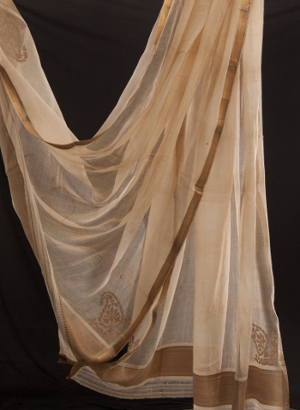Today’s ‘Muslin’

Muslin-like items sold in markets today
The Bengal muslin industry was decimated by the policies of the East India Company, causing it to be almost wiped out by the end of the 19th century. Today, the best examples of the finished product are unfortunately housed in Western museums and due to consumer ignorance multiple imitations have flooded the market under the ‘muslin’ label. Globally, many countries claim to be producing muslin for a variety of purposes. From India to China and USA, muslin exists as industrially woven, fine and plain cotton, or silk, or a combination of them, ranging in uses from baby wear to manufacturing jams and jellies.In Bangladesh, the birthplace of this fabric jamdani is the sole existing heir to a storied cloth. Jamdani is understood to be Persian for ‘jam’, (meaning flowers) and ‘dani’ (for container), i.e. the word possibly meaning the body as a vase displaying the motifs of the fabric. After Bangladesh became independent in 1971, Bangabandhu Sheikh Mujibur Rahman set up a Jamdani Palli (village for the weavers).
In 2013, UNESCO declared Bangladesh’s jamdani as an ‘Intangible Cultural Heritage of Humanity’. after determined and passionate campaigns undertaken by Ruby Ghuznavi, Monira Emdad, Aarong and others.
The jamdanis of the late 20th and early 21st centuries have rarely been of high-count cotton, and though beautifully made they are a far cry from the muslin jamdanis of the past.
The Bengal Muslin project has succeeded in reviving the fine, high-count (above 250) muslin weaving of the past, including its intricate motifs. The major varieties i.e. ‘durya (striped), mul-mul (plain), rong (coloured), charkhona (squared), ratna poka (beetle winged) and jamdani (flowered) have all been made on high-count cotton yarn.
Our efforts continue to push the envelope, attempting to do more and better.
Join us in this journey.


